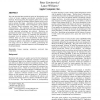Free Online Productivity Tools
i2Speak
i2Symbol
i2OCR
iTex2Img
iWeb2Print
iWeb2Shot
i2Type
iPdf2Split
iPdf2Merge
i2Bopomofo
i2Arabic
i2Style
i2Image
i2PDF
iLatex2Rtf
Sci2ools
SIGGRAPH
1994
ACM
1994
ACM
Animating images with drawings
The work described here extends the power of 2D animation with a form of texture mapping conveniently controlled by line drawings. By tracing points, line segments, spline curves, or filled regions on an image, the animator defines features which can be used to animate the image. Animations of the control features deform the image smoothly. This development is in the tradition of "skeleton"-based animation, and "feature"-based image metamorphosis. By employing numerics developed in the computer vision community for rapid visual surface estimation, several important advantages are realized. Skeletons are generalized to include curved "bones," the interpolating surface is better behaved, the expense of computing the animation is decoupled from the number of features in the drawing, and arbitrary holes or cuts in the interpolated surface can be accommodated. The same general scattered data interpolation technique is applied to the problem of mapping animatio...
Animation | Animator Defines Features | Computer Graphics | Feature"-based Image Metamorphosis | SIGGRAPH 1994 |
| Added | 10 Aug 2010 |
| Updated | 10 Aug 2010 |
| Type | Conference |
| Year | 1994 |
| Where | SIGGRAPH |
| Authors | Peter Litwinowicz, Lance Williams |
Comments (0)

